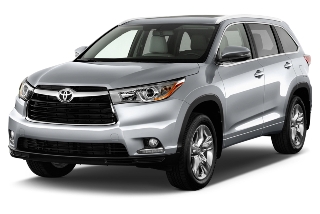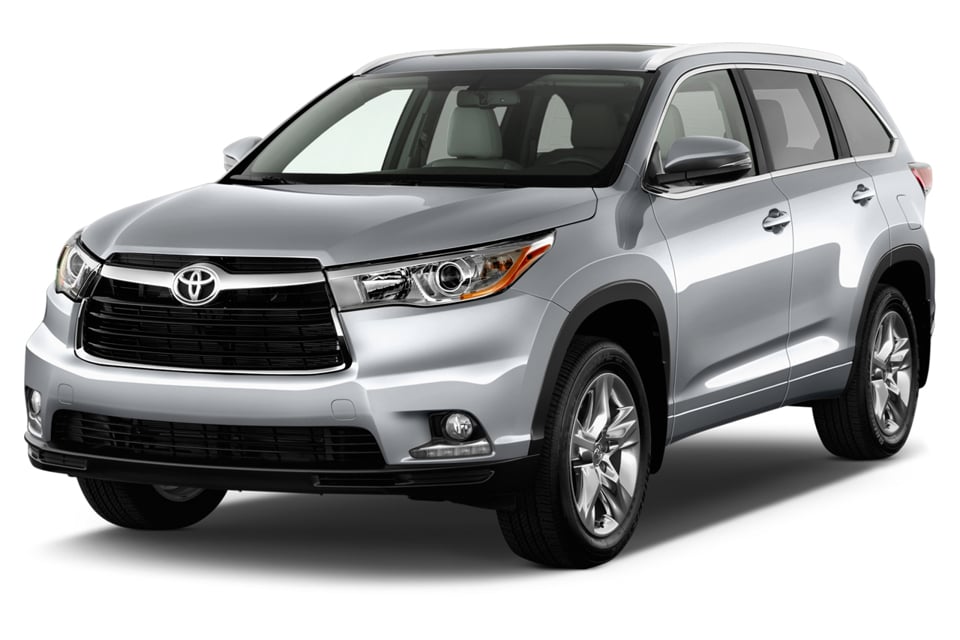

Executive wheels: Toyota sticker shock
Jeff Rundles //November 17, 2014//

2014 TOYOTA HIGHLANDER HYBRID LIMITED V6 AWD-i
2014 TOYOTA HIGHLANDER LIMITED V6 AWD
2014 TOYOTA RAV4 LIMITED AWD
I’m reviewing these two Toyota Highlanders and RAV4 together because they were so similar that it felt as if I were driving the same vehicle for three weeks rather than each one for one week. Sure, the RAV4 is a slightly smaller vehicle, but they feel the same.
I did notice some differences. First, the doors on the RAV4 are decidedly less heavy than those on the Highlanders. Second, the Hybrid Highlander has more engine fits and starts than the other two. Third, the Highlanders both feature a third-row seat not available in the RAV4, and this extra row folds down flat for wonderful storage.
Fourth – and this was almost undiscernible – the Highlanders both had more engine and were somewhat more powerful; however, the RAV4 was powerful enough. And finally, the Hybrid Highlander – like many Toyota/Lexus hybrid models – was marginally more powerful both off the line and on the highway because essentially, while there is better gas mileage ratings on the hybrid, the main aim of having a hybrid in bigger Toyota/Lexus models appears to be more power.
So, the basic engine in the gasoline Highlander is a 3.5-liter V6 rated at 270 hp; the mileage rating is 18 mpg city/24 mpg highway. In the Hybrid edition they have the same gasoline engine with some additional “eco” and energy savings modes, then they add in an electric motor for the hybrid part, and the combination has a horsepower rating of 280; the mileage is listed a 27 city/28 highway). The RAV4 features a 2.5-liter 4-banger with 176 hp (rated22 city/29 highway), but frankly it felt as though it had more power than that. I drove all three all over town, on the highway and up into the mountains and I really had to check closely to see which one of the three I was driving.
The truth is, I really like all three vehicles – I like the way they drive, the visibility, power, roominess and styling. I like all of the systems (the stereo, the climate control, the high-tech access, etc.). If any of the three vehicles were given to me, I would gladly take it and be happy driving it for many years to come. If I was pressed to name a favorite, I suppose I would say the Highlander Hybrid in that it has a hybrid engine and I would feel as though I was being “green” (even if that is mostly a ruse in this configuration).
But the key in this scenario is that it would be given to me. The downside of these Toyotas – and for that matter about a growing number of vehicles on the road these days – is that the price tags have gone nuts.
For instance, if you go to the Toyota website, the price you see for a MSRP on the Highlander is $29,415. For the RAV4 the MSRP is advertised at $23,680. I doubt very seriously whether a vehicle at that price is ever truly available. The bottom line on my test-drive vehicles was as follows: RAV4: MSRP of $29,720 and with additions $32,444; Highlander Hybrid: $49,790 and with additions (car mats and destination) $50,875; and, Highlander Limited: MSRP $43,590 and with car mats and destination $44,675. That’s $9,000 to over $20,000 more than the come-on.
Toyota makes just about the best vehicles on the market, and these three vehicles in particular are demonstrably excellent, but I know from driving Hyundais, Mazdas and Kias that excellent cars don’t have to be this expensive.
One great example: The 2014 Hyundai Santa Fe Limited AWD. MSRP of $35,750, 3.3-liter V6 with 290 hp rated at 18/24, with much longer warranty 100K/10 yrs. vs. 60k/5 yrs.).
Just sayin’. Toyota has a great reputation and wonderful track record but – and this becoming true in many lines – it is running the risk of pricing itself out of the average car buyer market. My neighbor is on her second Highlander and when I told her the price tag of the hybrid, her jaw dropped to the pavement. She could afford it, but at $50,000, she wouldn’t.
That’s too bad. These companies made their luxury divisions for people who would pay more – Lexus for Toyota, Acura for Honda, Infiniti for Nissan, Audi for VW, etc. – but it seems to me they have to keep at least some of their regular lines’ models within the reach of everyday people or the whole pyramid will collapse.
That won’t be good for anyone – luxury or normal buyers alike. These three Toyota SUV models are excellent vehicles, and I would heartily recommend them to anyone looking for something like this. I suppose the main problem in this cost escalation is in all the electronics we all seem to want in our vehicles these days, and these three are no exception.
There’s power everything, keyless entry, automatic liftgates, a gadzillion air bags, blind spot monitoring, Bluetooth, voice commands, hook-ups for smart phones, apps, pre-collision systems, panoramic sunroofs – it’s a wonder they even have luxury divisions since they’ve stuck all the luxury stuff here.
I just think there are limits, and that I miss cars that were fun to drive for the driving rather than the stuff. On these three vehicles, if I take away the measurement on cost/benefit, I would rate them all as Four Wheels out of Four. As it is, sticker shock alone makes me lower the ratings to:
THREE WHEELS (OUT OF FOUR)
























